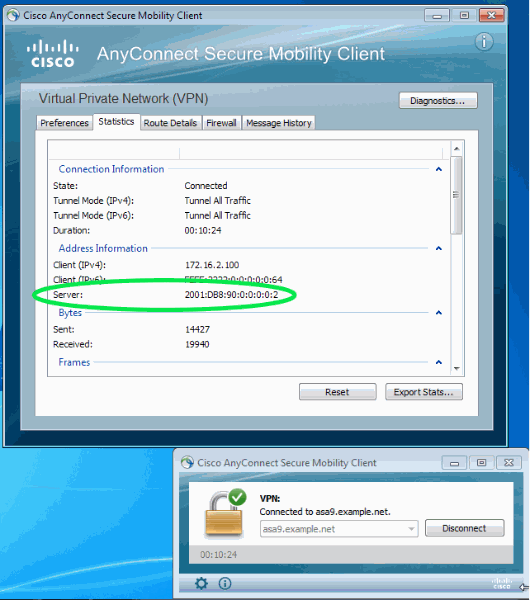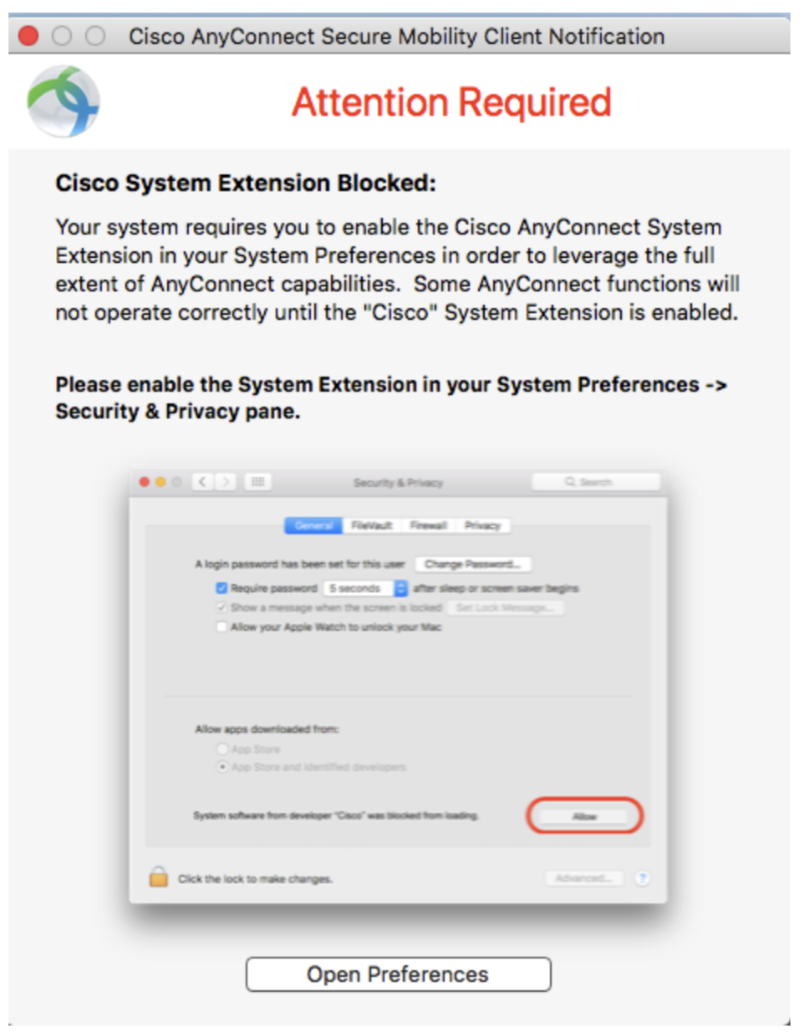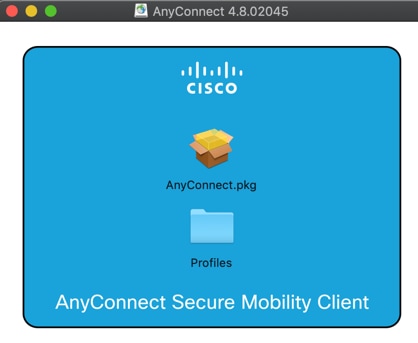Perhaps more importantly, while setting in these two files the parameter 'RunAtLoad' to 'false' indeed prevents the annoying reinstallation of the application 'Cisco AnyConnect Secure Mobility Client.app' as a login item after a restart, it also makes the vpn in general disfunctional. Cisco AnyConnect Secure Mobility Client for Mac lies within System Tools, more precisely Remote Computing. The actual developer of this Mac application is Cisco. The unique ID for this app's bundle is com.cisco.vpn. You can run Cisco AnyConnect Secure Mobility Client on Mac OS X 10.6 or later. Cisco AnyConnect is the recommended VPN client for Mac. The built-in VPN client for Mac is another option but is more likely to suffer from disconnects. Overview Stanford's VPN allows you to connect to Stanford's network as if you were on campus, making access to restricted services possible. To connect to Cisco AnyConnect follow the instructions in Connect to AnyConnect VPN for Mac OS X. Installing Cisco AnyConnect for macOS Click on the Download button under the AnyConnect for macOS (Recommended) section on the Downloads & Guides page. Enter your Internet ID and password, if prompted.
For additional information, refer to the AnyConnect configuration guide.
Client Download

Unlike the ASA, the MX does not support web deploy or web launch, a feature that allows end users to access a web page on the AnyConnect server to download the AnyConnect client. With the MX, there are download links to the client software on the AnyConnect settings page on the dashboard, however, the download links are only available to the Meraki dashboard admin and not the end user. We do not recommend sharing the down link with users as the link expires after every five minutes of loading the AnyConnect settings page.
We recommend downloading the AnyConnect client directly from Cisco.com as there may be an updated version in the Cisco repository. Refer to the doc for the AnyConnect clientrelease notes. We also recommend using either Meraki Systems Manager, an equivalent MDM solution, or Active Directory to seamlessly push the AnyConnect software client to the end user's device.
AnyConnect requires a VPN client to be installed on a client device. The AnyConnect client for Windows, MacOS, and Linux are available on the Client Connection section of the AnyConnect configuration page on the dashboard and can be downloaded by a Meraki dashboard administrator. Please note, the download links on the Meraki dashboard expire after five minutes. The AnyConnect client for mobile devices can be downloaded via the respective mobile stores. You can also download other versions (must be version 4.8 or higher) of the AnyConnect client from Cisco.com if you have an existing AnyConnect license. AnyConnect web deploy is not supported on the MX at this time.
- Installing the AnyConnect client
- You only need the VPN box checked. Once the client has been installed on the device, open the AnyConnect application and specify the hostname or IP address of the MX (AnyConnect server) you need to connect to.
AnyConnect Profiles
An AnyConnect profile is a crucial piece for ensuring easy configuration of the AnyConnect client software, once installed. The MX does not support the use of custom hostnames for certificates (e.g. vpn.xyz.com). The MX only supports use of the Meraki DDNS hostname for auto-enrollment and use on the MX. With the Meraki DDNS hostname (e.g. mx450-xyuhsygsvge.dynamic-m.com) not as simply as a custom hostname, the need for AnyConnect profiles cannot be overemphasized. Profiles can be used to create hostname aliases, thereby masking the Meraki DDNS with a friendly name for the end user.
Cisco AnyConnect client features are enabled in AnyConnect profiles. These profiles can contain configuration settings like server list, backup server list, authentication time out, etc., for client VPN functionality, in addition to other optional client modules like Network Access Manager, ISE posture, customer experience feedback, and web security. It is important to note that at this time, the Meraki MX does not support other optional client modules that require AnyConnect head-end support. For more details, see AnyConnect profiles.

When a profile is created, it needs to get pushed to the end user's device. There are three ways to do this.
1. Through the AnyConnect server (MX): If profiles are configured on the dashboard, the MX will push the configured profile to the user's device after successful authentication.
2. Through an MDM solution: Systems Manager, an equivalent MDM solution, or Active Directory can be used push files to specific destinations on the end user's device. Profiles can also be pushed to the following paths:
Windows
%ProgramData%CiscoCisco AnyConnect Secure Mobility ClientProfile
Mac OS X
/opt/cisco/anyconnect/profile
Linux
/opt/cisco/anyconnect/profile
3. Manually: Profiles can also be preloaded manually to the same paths as listed above.
How to Create a Profile
Profiles can be created using the AnyConnect profile editor. The profile editor can be downloaded from the AnyConnect Settings page on dashboard or on cisco.com. Refer to this link for more details on AnyConnect profiles.
Using the profile editor: The profile editor can be downloaded from the AnyConnect Settings page on dashboard or on Cisco.com. The profile editor only runs on Windows operating systems. The screenshot below shows a configured server ton the Server List Entry option.
When configuration is complete, save the profile. It is recommended to use a unique file name to avoid profile overrides by other AnyConnect servers, then you can upload the file to the profile update section on the AnyConnect settings page.
Please note that only VPN profiles are supported on the MX at this time. This means you cannot push NVM, NAM, or Umbrella profiles via the MX.
- Select enable profiles, upload your xml file, and save your configuration
- After a user successfully authenticates, the configured profile gets pushed to the user's device automatically
- The result of the .xml can be seen below, after successful authentication to the AnyConnect server; this gives users the ease of selecting VPN servers on the AnyConnect client
The Meraki DDNS hostname is not easy to remember, therefore end users are not expected to use it directly. Profiles should be used to make connecting to the AnyConnect server easy for end users.
Introduction
This document describes the custom installation process for Anyconnect with the use of the MAC command line.
Prerequisites
Requirements
Cisco recommends that you have knowledge of these topics:
- Anyconnect
- MacOS x 10.14.6
Components Used
The information used in the document is based on this software:
MacOS X 10.14.6
Anyconnect 4.8 MR2

The information in this document was created from the devices in a specific lab environment. All of the devices used in this document started with a cleared (default) configuration. If your network is live, ensure that you understand the potential impact of any command.
Background Information
There are 2 deployment types for Anyconnect, one is a weddeploy based installation which is automatically installed by a Cisco Firewall or Router, and a pre-deploy installation, which requires user intervention.
In this scenario, the pre-deploy installation is customized on MAC endpoints to only instal the selected modules.
Method 1
Step 1. Convert the .dmg Package
Convert the .dmg package from a read-only state to read-write, with the use of Disk Utility or hdiutil as shown in the image.
hdiutil convert anyconnect-macos-4.8.02045-predeploy-k9.dmg -format UDRW -o anyconnect-macos-4.8.02045-predeploy-k9-rw.dmg
Step 2. Run the Converted File
Run the converted file anyconnect-macos-4.8.02045-predeploy-k9-rw.dmg in order to initiate the installation process.
Step 3. Generate the Installer XML File
This example is intended to send all the installer options to a text file called vpn_install_choices.xml, which is located in the Downloads folder. For example:
Step 4. Extract the Install Options
The code presented, is an XML code extracted from the vpn_install_choises.xml file, it contains the necessary code to custom install all the Anyconnect modules:
Step 5. Save the Code with the Required Modules
Save the new code (overwrite the original file vpn_install_choices.xml) and modify it to either skip (0) or install (1) the modules.
For this example, VPN, web security, AMP, DART, posture, ISE posture and Umbrella modules are set to 1 in the integer value, in order to get installed.
The integer value for the NVM module is set to 0, in order to be skipped by the installation package.
Step 6. Locate the Install Choices File
The vpn_install_choices.xml file is now available in the /Volumes/AnyConnect 4.8.02045/ directory, as shown in the image.
Step 7. Install Anyconnect via Command Line
Install the Anyconnect client, based on the XML vpn_install_choices.xml file. As shown in the image:
Method 2
Step 1. Convert the .dmg Package
Convert the dmg package from a read-only state to read-write, with the use of Disk Utility or hdiutil as shown in the image.
Step 2. Convert the Installation Package
Cisco Anyconnect Mobility Client Mac
Convert the .pkg file into .zip as shown in the image.
Cisco Anyconnect Secure Mobility Client
Step 3. Extract the .zip File
Step 4. Install the Desired Modules
You can now install module by module, the VPN module must be installed first with the core-vpn-webdeploy-k9.dmg as shown in the image.
Verify
Cisco Anyconnect Vpn Client Mac Configuration
In order to verify the Anyconnect installation and the selected modules, in the Anyconnect application, navigate to the Apple's Menu Bar > Cisco Anyconnect Secure Mobility Client and select About Cisco AnyConnect as shown in the image.
Cisco Anyconnect Mobility Client Mac Big Sur
Confirm the Installed Modules section as shown in the image.
